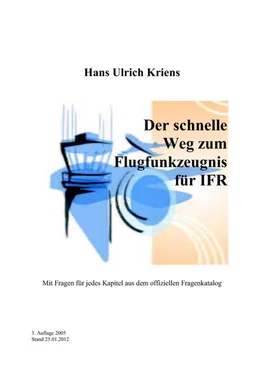Hans Ulrich Kriens - Der schnelle Weg zum Flugfunkzeugnis für IFR
Здесь есть возможность читать онлайн «Hans Ulrich Kriens - Der schnelle Weg zum Flugfunkzeugnis für IFR» — ознакомительный отрывок электронной книги совершенно бесплатно, а после прочтения отрывка купить полную версию. В некоторых случаях можно слушать аудио, скачать через торрент в формате fb2 и присутствует краткое содержание. Жанр: unrecognised, на английском языке. Описание произведения, (предисловие) а так же отзывы посетителей доступны на портале библиотеки ЛибКат.
- Название:Der schnelle Weg zum Flugfunkzeugnis für IFR
- Автор:
- Жанр:
- Год:неизвестен
- ISBN:нет данных
- Рейтинг книги:5 / 5. Голосов: 1
-
Избранное:Добавить в избранное
- Отзывы:
-
Ваша оценка:
- 100
- 1
- 2
- 3
- 4
- 5
Der schnelle Weg zum Flugfunkzeugnis für IFR: краткое содержание, описание и аннотация
Предлагаем к чтению аннотацию, описание, краткое содержание или предисловие (зависит от того, что написал сам автор книги «Der schnelle Weg zum Flugfunkzeugnis für IFR»). Если вы не нашли необходимую информацию о книге — напишите в комментариях, мы постараемся отыскать её.
Der schnelle Weg zum Flugfunkzeugnis für IFR — читать онлайн ознакомительный отрывок
Ниже представлен текст книги, разбитый по страницам. Система сохранения места последней прочитанной страницы, позволяет с удобством читать онлайн бесплатно книгу «Der schnelle Weg zum Flugfunkzeugnis für IFR», без необходимости каждый раз заново искать на чём Вы остановились. Поставьте закладку, и сможете в любой момент перейти на страницу, на которой закончили чтение.
Интервал:
Закладка:
a) Magnetic heading to the station (no wind)
b) True bearing from the station
c) True heading to the station
d) Magnetic bearing from the station
28. What is the Q-code for "magnetic bearing from the station"?
a) QDR
b) QTE
c) QDM
d) QFE
29. When transmitting time, which time system shall be used?
a) Local time (LT), 24-hour clock
b) Local time (LT) A.M. and P.M.
c) No specific system, as only the minutes are normally required
d) Coordinated universal time (UTC)
30. The time is 4:15pm. What is the correct way of transmitting this time if there is a possibility of confusion?
a) Four fifteen P.M.
b) Sixteen fifteen
c) four fifteen in the afternoon
d) One six one five
31. When the term "CAVOK" is used in an aviation routine weather report (METAR), the values of visibility and clouds are:
a) Visibility 10 km or more, no clouds below 5000 ft/GND
b) Visibility 10 km or more, no clouds below 1500 ft/GND
c) Visibility more than 8 km, no clouds below 3000 ft/GND
d) Visibility more than 5000 m, no clouds below 1500 m/GND
32. The time is 9:20 am. What is the correct way of transmitting this time if there is no possibility of confusion (same hour)?
a) Two zero
b) Twenty
c) Two zero this hour
d) Nine twenty A.M.
33. The transition level is determined on the basis of ...
a) transition altitude and QNH
b) transition height and QNH
c) transition altitude and QFE
d) transition height and QFE
34. The vertical dimension of the transition layer must be at least:
a) 1000 ft
b) 500 ft
c) 1500 ft
d) 2000 ft
35. The weather report in an ATIS broadcast contains the term "CAVOK". This means that an arriving aircraft has to expect ...
a) less than 5/8 clouds below 5000 ft
b) light precipitation
c) thunderstorm
d) no clouds below 5000 ft GND
36. Which are the units of measurement used in flight operation for wind direction and velocity (except for take-off and landing)?
a) Degrees magnetic and kilometers
b) Degrees true and kilometers
c) Degrees magnetic and miles
d) Degrees true and knots
37. Which are the units of measurement used in flight operation for wind direction and velocity for take-off and landing?
a) Degrees magnetic and knots
b) Degrees true and kilometers
c) Degrees magnetic and miles
d) Degrees true and knots
38. Which time will be issued by ATC, if an arriving aircraft on an IFR flight has to hold over the navigational aid serving as clearance limit, when holding of more than 20 minutes is expected? The ...
a) estimated time of arrival (ETA)
b) estimated elapsed time (EET)
c) estimated time en-route (ETE)
d) expected approach time (EAT)
39. What does "friction coefficient 45" in a runway report mean?
a) Breaking action medium
b) Braking action good
c) Braking action poor
d) Braking action not measurable
40. What does "friction coefficient 20" in a runway report mean?
a) Breaking action medium
b) Breaking action good
c) Breaking action poor
d) Breaking action unreliable
41. The published transition altitude is 5000 ft, the present QNH is 1005 hPa. What is the transition level?
a) FL 50
b) FL 60
c)FL 70
d) FL 80
42. The published transition altitude is 5000 ft, the present QNH is 1015 hPa. What is the transition level?
a) FL 50
b) FL 60
c) FL 70
d) FL 80
43. The published transition altitude is 5000 ft, the present QNH is 977 hPa. What is the transition level?
a) FL 50
b) FL 80
c) FL 70
d) FL 60
44. An aircraft on an IFR flight at FL 100 approaches an aerodrome for landing. The QNH given is 1018 hPa; the transition altitude is 5000 ft. When shall the pilot change the altimeter setting to QNH? When...
a) leaving FL 100
b) passing FL 50
c) passing FL 70
d) passing FL 60
45. The pilot of an arriving IFR flight shall change altimeter setting from 1013,2 hPa to QNH during the descent...
a) when passing the transition altitude
b) when commencing descent
c) after having passed the transition layer
d) when passing the transition level
46. The pilot of a departing IFR flight shall change altimeter setting from QNH to standard altimeter setting 1013,2 hPa when ...
a) passing transition level
b) reaching transition level
c) passing transition altitude
d) leaving the transition layer
Solutions:
1a, 2a, 3d, 4d, 5a, 6c, 7d, 8c, 9c, 10b, 11a, 12a, 13d, 14b, 15b, 16a, 17a, 18a, 19b, 20b, 21a, 22a, 23d, 24a, 25b, 26c, 27d, 28a, 29d, 30d, 31a, 32a, 33a, 34a, 35d, 36d, 37a, 38d, 39b, 40c, 41c, 42b, 43b, 44d, 45d, 46c
Chapter 2
Aviation Organizations
International Civil Aviation Organization ICAO
The rapid development in international aviation prior and after the second world war forced the the United Nation to find a aviation organization. The first step was done in 1944 when the PICAO (Provisional International Civil Aviation Organisation), a preliminary aviation organization, was found in Chicago. After acceptance of the “Agreement of Chicago” the International Civil Organization (ICAO) was found on April 4 th1947. More than 140 members of the United Nations participate this organisation. In the year 1967 the Bundesrepublik Deutschland became also member of the ICAO.
Bundesminister für Verkehr
The Bundesminister für Verkehr (BMV) is responsible for all aviation affairs in the Bundesrepublik Deutschland such as aviation law, aviation admission, research, international cooperation and air traffic.
For this behalf the BMV has found several offices to look after special assignments:
LBA (Luftfahrtbundesamt)
DWD (Deutscher Wetterdienst)
Deutsche Flugsicherung DFS GmbH
DFS Deutsche Flugsicherung GmbH
The Deutche Flugsicherung DFS GmbH was found as BFS (Bundesanstalt für Flugsicherung) in 1953 and changed to a privat GmbH in 1994.
The DFS is responsible for air traffic control in the controlled airspace of Germany and on internatioal German airports.
The DFS may forbid totally or partly visual air traffic in airspaces “C” and/or “D”.
Die DFS consists of
Unternehmenszentrale, situated at Langen (Hessen)
Control tower service at the international airports and aera control at Bremen, Berlin, Karlsruhe, München and Langen
The air traffic services comprises
Air traffic control service This will be done in the control airspace (C, D, E) by radar and/or tower control service. Clearances and advises will be done via radiotelephony.
The three basic control units are TOWER Control (TWR), Approach Control(APP) and Area Control (ACC)
Flight information service This service is executed by radar service to provide pilots with information and hints necessary for a safe and afficient conduct of flights. This service is only during flight available.
Flight alerting service With filing a flight plan the pilot gets flight alerting service automatically either by AIS (aeronautical information service) or by aerodrome control tower.
Aeronautical information service This service is only available prior or after the flight. Here you can file flight plans and they are responsible for all questions regarding flight plan, airspace structure, NOTAMs and procedures. This service is available only via telephone, FAX or internet.
Aeronautical teletype service This service is responsible for the collection and dissemination of flight plans, NOTAMs etc. Pilots normally don’t have contact with this service
Читать дальшеИнтервал:
Закладка:
Похожие книги на «Der schnelle Weg zum Flugfunkzeugnis für IFR»
Представляем Вашему вниманию похожие книги на «Der schnelle Weg zum Flugfunkzeugnis für IFR» списком для выбора. Мы отобрали схожую по названию и смыслу литературу в надежде предоставить читателям больше вариантов отыскать новые, интересные, ещё непрочитанные произведения.
Обсуждение, отзывы о книге «Der schnelle Weg zum Flugfunkzeugnis für IFR» и просто собственные мнения читателей. Оставьте ваши комментарии, напишите, что Вы думаете о произведении, его смысле или главных героях. Укажите что конкретно понравилось, а что нет, и почему Вы так считаете.












